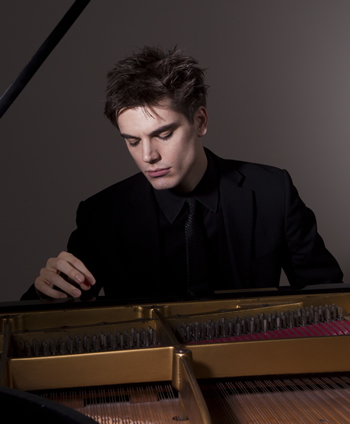First, a disclaimer: When it comes to the St. Stephens Concert Series, and in particular its regular, home-grown participant, Andrew Tyson, this listener is an unapologetic fan.
Many in the audience have been watching this gifted young musician since his student days, and some – this critic included – got on a chartered bus last year to attend his extremely well-received Kennedy Center debut. (Well-received by the audience at least; the Washington Post‘s critic was a little huffy.) In the past couple of years Tyson has been a finalist in at least two of the world’s most prestigious competitions: Leeds and the Queen Elisabeth of Belgium.
His increasing public profile is probably a good reason the sanctuary at the church on a sunny Sunday afternoon was almost full.
An appealing program surely did no harm. The selected compositions seemed to have their own rhythm, order, and inevitability. Tyson started with Handel’s utterly charming “Harmonious Blacksmith” — a movement from one of his suites — and continued with Mendelssohn’s Rondo Capriccioso. Eschewing the customary sequencing by chronology, Tyson then back-tracked to Mozart and the composer’s Fantasy in C minor, K.475, and the Sonata in C Minor, K.457. (Mozart himself approved publishing these works together and in this sequence in 1785.)
He finished with Schumann’s Symphonic Etudes, one of the monumental, multi-segment piano masterpieces of the master’s early years.
So how did it go?
When he was still a 19-year-old student at Curtis, studying with Claude Frank, Tyson demonstrated at another St. Stephens’s recital that he clearly possessed the skill set, temperament, confidence, and built-in musicality to be on a concert stage.
What has happened since – and what was in evidence in this most recent recital – is that excellence has been burnished with ever-developing artistry. “Artistry” can mean many things, but primarily in Tyson’s case it is that he has found and developed his own voice. In “Harmonious Blacksmith,” to take just one example, his voicing of melodic lines, some obvious, others somewhat hidden in the thick of it, was to these ears a completely new and wonderful experience. Overall, the performance was intensely loving and affectionate. His control of dynamics, always a strength, is now breathtaking.
His performance of the introduction portion of the Rondo Capriccioso was another thing of uncommon beauty. In his hands, the music seemed at times a simple lament, then a cry from the heart, and finally a joyful song of redemption. The virtuosic rondo itself was assured and muscular, overall, but always ready to embrace a tender moment as well.
Mozart’s C minor Fantasy is a miracle of his later years and an endlessly surprising and profoundly moving construction of kaleidoscopic mood shifts. Most of it is incredibly dark and full of pain. Still, the composer whose nickname is Mr. Sunshine found ways to introduce hope and respite. Tyson easily faced off its technical and interpretive challenges.
The same thing can be said for the performance of the composer’s K.457 Sonata. The piece begins with an angry tempest of rising arpeggios in the tonic key, and the listener expects a musical depiction of horror and despair! But Mozart, also known as the Eternal Child, can’t quite help himself. Many subsequent themes, as well as the second movement, are in beguiling major keys. Even the steadily fiery final movement can hardly be associated with any serious psychological stress. Tyson relished in the composition’s underlying playfulness and delivered a sensitive, accurate performance.
The program concluded with the majestic Symphonic Etudes of Schumann. The piece was long in the making and even longer in the revisions and restorations by Schumann himself and Brahms. Tyson performed the now most-common configuration composed of the main theme, twelve of the etudes and variations Schumann chose to include originally, plus the five variations that Schumann at some time pared away but Brahms restored in his edition in the late 19th century.
The dominant impression taken from Tyson’s performance is one of utter fearlessness. As he has developed over the years, he has allowed himself to play with a focused powerfulness – power that does not overwhelm the musical intent or lead to a litter of missed notes on the stage floor. Listening to each of the many contrasting sections, it seemed to this listener that there might be no tonal or dynamic shading, no voicing challenge that he would not be able to coax out of the piano.
You might differ with interpretation here and there. I would have preferred a lower dynamic level at the lovely Brahms-restored Variation V, but overall – and especially in the triumphant concluding Etude XII – this was a performance that reverberated with authority, attention to detail, a good sense of the piece’s overall architecture, and an unerring rhythmic sense.
For his encore, Tyson chose Godowsky’s transcription of “The Swan,” from Saint-Saëns Carnival of the Animals. It’s not one of Godowsky’s best – the virtuosic busy-ness seems to distract from the warm romanticism at the core – but Tyson was a persuasive advocate.











